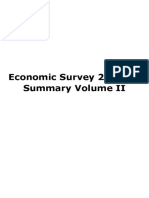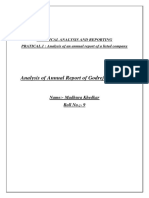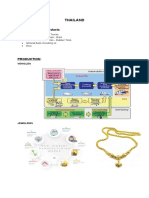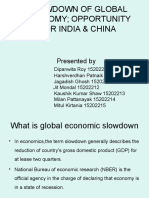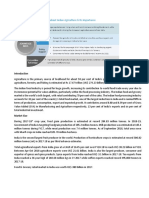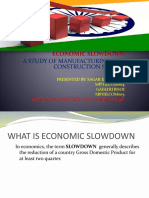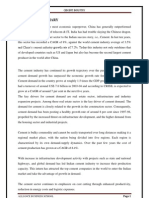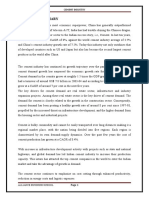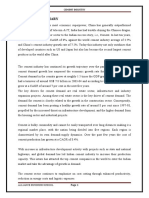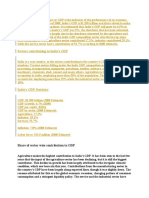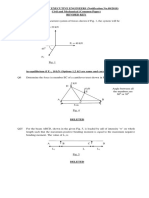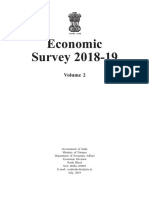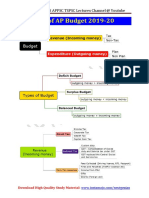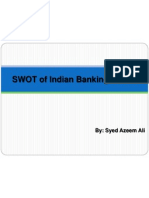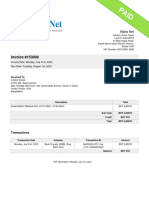Economic Survey 2018-19 Highlights - Part III: Here Here
Economic Survey 2018-19 Highlights - Part III: Here Here
Uploaded by
rushikeshCopyright:
Available Formats
Economic Survey 2018-19 Highlights - Part III: Here Here
Economic Survey 2018-19 Highlights - Part III: Here Here
Uploaded by
rushikeshOriginal Description:
Original Title
Copyright
Available Formats
Share this document
Did you find this document useful?
Is this content inappropriate?
Copyright:
Available Formats
Economic Survey 2018-19 Highlights - Part III: Here Here
Economic Survey 2018-19 Highlights - Part III: Here Here
Uploaded by
rushikeshCopyright:
Available Formats
Economic Survey 2018-19 Highlights - Part III
Click here for Part II and here for Part I
Why in news?
The Union Minister for Finance and Corporate Affairs, Ms. Nirmala Sitharaman
tabled the Economic Survey 2018-19 in the Parliament.
What are the key highlights?
EXTERNAL SECTOR
World Trade - As per WTO, World trade growth has slowed down to 3% in
2018, much below the growth rate of 4.6% in 2017.
This was mainly because of -
i. the introduction of new and retaliatory tariff measures
ii. heightened US-China trade tensions
iii. weaker global economic growth
iv. volatility in financial markets
India’s balance of payment situation witnessed some signs of deterioration
during H1 of 2018-19.
This was due to the sharp rise in crude oil prices, causing higher current
account deficit (CAD), in turn, due to higher trade deficit.
However, CAD moderated somewhat in Q3-2018-19 as international crude oil
prices eased sequentially towards the end of 2018.
Trade - The growth rate of merchandise exports and imports fell in 2018-19
compared to previous year.
This was attributable to the slower growth of world output and trade, along
with lower domestic GDP growth in 2018-19, among other factors.
The contribution of net services to financing merchandize trade deficit has
fallen from around 62% in 2016-17 to around 43% in 2018-19.
This reflects a weak performance of service exports in recent times.
Notably, during first half of 2017-18, the Net surplus in the services had
financed about 49% of India’s merchandise deficit.
Capital flows - Net capital flows moderated in April-December of 2018-19.
This was despite robust foreign direct investment (FDI) inflows as it was
outweighed by withdrawals under portfolio investment.
Remittances - India remained a top remittance recipient country in 2018.
The net remittances by Indians employed overseas increased in 2018-19 (P-
Provisional) compared to last year.
This is possibly due to improved income conditions in the Gulf countries,
along with rise in oil prices.
Foreign Exchange - Among the major economies running current account
deficit, India is the largest foreign exchange reserve holder.
India is also the 8th largest among all countries of the world in this regard.
India’s External Debt was US$521.1 billion at end-December 2018, 1.6%
lower than its level at end-March 2018.
The key external debt indicators reflect that India’s external debt is
sustainable.
Total liabilities-to-GDP ratio, inclusive of both debt and non-debt
components, has declined from 43% in 2015 to about 38% at end of 2018.
The share of foreign direct investment has risen and that of net portfolio
investment has fallen in total liabilities.
This reflects a transition to more stable sources of funding the current
account deficit.
Indian Rupee traded in the range of 65-68 per US$ in 2017-18 but
depreciated to a range of 70-74 in 2018-19.
During H1 of 2018-19, rupee remained weak due to concerns related to -
i. widening of CAD owing to rising crude oil prices
ii. tightening of financial conditions caused by increase in Federal Funds
rate by the US Federal Reserve
Import - The income terms of trade is a metric that measures the purchasing
power to import.
This has been on a rising trend, possibly because the growth of crude prices
has still not exceeded the growth of India’s export prices.
Exchange rate in 2018-19 has been more volatile than in the previous year.
This was mainly due to volatility in crude prices, but not much due to net
portfolio flows.
Trade composition - Composition of India’s exports and import basket in
2018-19 (P):
i. Exports (including re-exports) - around Rs. 23, 07,000 Cr
ii. Imports - around Rs. 35, 94,000 Cr
The composition of India’s exports and import basket has almost remained
unchanged in 2018-19 over 2017-18.
Petroleum products, precious stones, drug formulations, gold and other
precious metals continue to be top export items.
Crude petroleum, pearl, precious, semi-precious stones and gold remain as
top import items.
Trading Partners - India’s main trading partners continue to be the US,
China, Hong Kong, the UAE and Saudi Arabia.
India has signed 28 bilateral/multilateral trade agreements with various
country/group of countries.
In 2018-19, India’s exports to countries with which it has a trade agreement
stood at US$121.7 billion.
This accounts for close to 37% of India’s exports to all the countries.
Similarly, in the same year, India’s imports from countries with which it has
a trade agreement stood at US$266.9 billion.
This accounts for 52% of India’s imports from all the countries.
Logistics industry of India is currently estimated to be around US$215
billion.
There have been significant developments in this industry.
This has led to an increase in India's rank in World Bank's 2016 Logistics
Performance Index.
In 2018, India stood at 44th rank.
AGRICULTURE AND FOOD MANAGEMENT
Contribution - The contribution of Agriculture’s Gross Value Added (GVA)
to overall GVA has been declining (14.4% in 2018-19).
Gross Value Added (GVA) in agriculture improved from a negative 0.2% in
2014-15 to 6.3% in 2016-17.
But it again decelerated to 2.9% in 2018-19.
However, agriculture is still a crucial sector, as a large proportion of the
population engage in agriculture.
Gross Capital Formation (GCF) in agriculture as percentage of GVA declined
to 15.2% in 2017-18, as compared to 15.6% in 2016-17.
The public sector GCF in agriculture as a percentage of GVA increased to
2.7% in 2016-17 from 2.1% in 2013-14.
Women’s participation in agriculture has increased to 13.9% in 2015-16
from 11.7% in 2005-06.
Their concentration is now the highest (28%) among small and marginal
farmers.
Land holdings - The number of operational land holdings and area under
operation have shifted towards small and marginal farmers.
Water use - Around 89% of groundwater extracted is used for irrigation.
Crops such as paddy and sugarcane consume more than 60% of irrigation
water.
The States like Tamil Nadu, Karnataka, Maharashtra and Andhra Pradesh,
which have high land productivity, tend to have very low irrigation water
productivity.
So, the focus should shift from land productivity to ‘irrigation water
productivity’.
Therefore devising policies to incentivize farmers to improve water use
should become a national priority.
Thrust should be on micro-irrigation that can improve water use efficiency.
Fertilizer response ratio has been declining over time.
In this regard, organic and natural farming techniques including Zero
Budget Natural Farming (ZBNF) can improve both water use efficiency and
soil fertility.
Technology adoption - Over the years, several new challenges have
emerged before the sector including fragmentation of agricultural holdings
and depletion of water resources.
So, adoption of a resource-efficient, ICT based climate-smart agriculture can
enhance agricultural productivity and sustainability.
Adopting appropriate technologies through Custom Hiring Centers and
implementation of ICT should be strategized.
Significantly, small-holder farming can be a profitable livelihood opportunity
with the application of appropriate technologies.
Diversification of livelihoods is critical for inclusive and sustainable
development in agriculture and allied sectors.
Policies should focus on
i. dairying (India is the largest producer of milk)
ii. livestock rearing particularly of small ruminants
iii. fisheries sector (India is the third largest producer)
Food security - Agriculture is critical for the country’s food security.
The rationalisation of food subsidy and greater use of technology in food
management will ensure food security for all.
INDUSTRY
The industrial growth in terms of Index of Industrial Production (IIP)
registered 3.6% in 2018-19 as compared to 4.4% growth rate in 2017-18.
The moderation in IIP growth is mainly due to subdued manufacturing
activities in Q3 and Q4 of 2018-19.
This, in turn, was due to -
i. slower credit flow to medium and small industries
ii. reduced lending by NBFCs owing to liquidity crunch
iii. tapering of domestic demand for key sectors such as automotive sector,
pharmaceuticals, and machinery and equipment
iv. volatility in international crude oil prices, etc
Meanwhile, the overall Index of Eight Core Industries registered a growth
rate of 4.3% in 2018-19 similar to the increase achieved in 2017-18.
India has considerably improved its ranking to 77th position (leapt 23 ranks)
in 2018 among 190 countries assessed by the World Bank Doing Business
(DB) Report, 2019.
INFRASTRUCTURE
Building sustainable and resilient infrastructure has been given due
importance with the formulation of sector specific programmes such as
SAUBHAGYA scheme, PMAY etc.
Road construction grew at 30 kms per day in 2018-19 as compared to 12 kms
per day in 2014-15.
Rail freight and passenger traffic grew by 5.33% and 0.64% respectively in
2018-19 as compared to 2017-18.
Total telephone connections in India touched 118.34 crore in 2018-19.
The installed capacity of electricity has increased from 3,44,002 MW in 2018
to 3,56,100 MW in 2019.
The challenge ahead is to mobilize adequate investment in infrastructure
sector, which runs into several trillions of dollars.
Public Private Partnerships are essential for addressing infrastructure gaps
in the country.
There is also a need for establishing an institutional mechanism to deal with
time-bound resolution of disputes in infrastructure sectors.
SERVICES SECTOR
Services sector (excluding construction) has a share of 54.3% in India’s GVA.
It has contributed more than half of GVA growth in 2018-19.
The services sector growth declined marginally to 7.5% in 2018-19 from
8.1% in 2017-18.
This was driven by deceleration in the growth of sub sectors such as trade,
hotels, transport, communication and broadcasting services.
However, growth of financial services, real estate and professional services
accelerated.
It is to be noted that India’s services sector does not generate jobs in
proportion to its share in GVA.
Service sector's share in employment is 34% in 2017 which is significantly
lesser that its share of 54% in GVA.
During 2018-19, FDI equity inflows into service sector fell by US$696 million
or 1.3% from the previous year to about US$28.26 billion.
In services, the IT-BPM (business process management) industry grew by
8.4% in 2017-18 to US$167 billion.
It is estimated to reach US$181 billion in 2018-19.
Tourism - India received 10.6 million foreign tourists in 2018-19 compared
to 10.4 million in 2017-18.
The foreign exchange earnings from tourism stood at US$27.7 billion in
2018-19 compared to US$28.7 billion in 2017-18.
SOCIAL INFRASTRUCTURE, EMPLOYMENT AND HUMAN DEVELOPMENT
The 17 SDGs (Sustainable Development Goals) and 169 targets envisaged in
the Agenda 2030 of the UN, are closely interrelated with social
infrastructure.
The public investments in social infrastructure like education, health,
housing and connectivity have a critical role in ensuring inclusive
development in a developing country like India.
Consequently, the improvement in HDI is also interlinked to SDGs as
evidenced in the correlation between SDG rankings and HDI rankings of the
States.
HDI - India’s HDI (Human Development Index) has improved significantly
over the years between 1990 and 2017.
The country’s HDI value increased from 0.427 to 0.640, but its position is
still lowest among its peer countries (Asian and developing economies).
As per the UNDP Human Development Index (HDI), India is ranked 130
among 189 countries.
Moreover, India also reflects inter-State disparities in regional and human
development, which are reflected by State level HDIs.
Education - In India, the percentage of GDP expended on education has
remained stagnant at around 3%.
With the available resources, India has made substantial progress in both
quantitative and qualitative indicators of education.
This is reflected in the improvements in -
i. Gross Enrolment Ratios
ii. Gender Parity Indices
iii. learning outcomes at primary school levels
However, the rural urban disparities in access to quality schooling and drop
out rates at senior secondary levels remain areas of concern.
Skilling - The Skilling ecosystem in India is equipping the youth to meet the
challenges of a dynamic labour market.
Short-term and long-term skilling are facilitated under programmes like
Pradhan Mantri Kaushal Vikas Yojana (PMKVY).
PMKVY has had positive impact on employment and incomes of the youth as
per evaluation studies.
The suggestions made in this regard in the Survey include -
i. introduction of the skill vouchers as a financing instrument to enable
youth obtain training from any accredited training institutes
ii. involving industry in setting up of training institutes in PPP mode, in
curriculum development, in provision of equipment, in training of
trainers, etc
iii. roping in personnel of Railways and para-military for imparting training
in difficult terrains
iv. creating a database of Instructors, skill mapping of rural youth by
involving local bodies to assess the demand-supply gaps
Employment - The PLFS (Periodic Labour Force Surveys) has reported
declining LFPR (labour force participation rate) along with increasing
unemployment rate.
Government has prioritized employment programmes like MGNREGS.
This is reflected in the upward trend in budget allocation and release of
funds to the States in the last 4 years.
Health - The expenditure on health has hovered around 1% of GDP during
the past few years.
Note: OOPE - Out of Pocket Expenditure; THE - Total Health Expenditure
Accessible, affordable and quality healthcare are being provided by the
Government under the National Health Mission and through new schemes
like Ayushman Bharat.
The select health indicators like MMR, IMR, U5MR have shown tremendous
improvement over the past few years.
Alternative healthcare, National AYUSH Mission, was launched to provide
cost effective and equitable AYUSH healthcare.
Household autonomy of women is the first step towards achieving
empowerment and becoming agents of change in patriarchal societies like
India.
In this context, financial inclusion initiatives have improved the household
autonomy of women as reflected by the NFHS (national family health survey)
data.
Connectivity is critical for rural areas, to improve quality of lives of the poor
by enhancing access to various social services, education, health and access
to markets.
In this regard, PMGSY (Pradhan Mantri Gram Sadak Yojana) has played a
crucial role in connecting the unconnected in rural India and enhanced their
livelihood opportunities.
Around 1,90,000 km of rural roads were constructed under PMGSY since
2014.
Housing - Government has accorded highest priority to rural housing, by
providing dwelling with all basic facilities to the most needy under PMAY-G
(Pradhan Mantri Awas Yojana - Gramin).
About 1.54 crore houses were completed under PMAY as against a target of
1 crore pucca houses with basic amenities by 31st March, 2019.
Way Forward - To reap the benefits of demographic dividend, the
government is committed to improve the outcomes in education and skilling,
and to provide employment and affordable healthcare to all.
India's march towards achieving SDGs is firmly anchored in investing in
human capital and inclusive growth.
Source: Ministry of Finance Website
You might also like
- Harischandra MarketingDocument3 pagesHarischandra MarketingPatavi59% (17)
- Derbi Senda X Race SM 2006Document81 pagesDerbi Senda X Race SM 2006Sergio Bernal100% (4)
- Identification Vs SpecificationDocument3 pagesIdentification Vs SpecificationEdgar RuizNo ratings yet
- Transfer DeedDocument1 pageTransfer DeedAli BukhariNo ratings yet
- Role of Minerals in The National EconomicsDocument28 pagesRole of Minerals in The National Economicspt naiduNo ratings yet
- Vol IiDocument59 pagesVol IiprashantNo ratings yet
- Economic Survey 2019Document11 pagesEconomic Survey 2019The Indian ExpressNo ratings yet
- Economic Survey 2019-20 - Ibef: Creating Jobs and Growth by Specializing in Network ProductsDocument4 pagesEconomic Survey 2019-20 - Ibef: Creating Jobs and Growth by Specializing in Network ProductsAMITAVA RAYNo ratings yet
- Macro Economic Frame Work StatementDocument5 pagesMacro Economic Frame Work StatementPreethi RatnalaNo ratings yet
- Ecs2 2019Document52 pagesEcs2 2019SRIJITNo ratings yet
- Nda E: Study Material ForeconomicsDocument7 pagesNda E: Study Material ForeconomicsmgharwalmgharwalNo ratings yet
- Vol. II: Economic SurveyDocument53 pagesVol. II: Economic SurveySubh sNo ratings yet
- MBA E4b - 360-Prateek Thakur - GCSA (02-04-20)Document3 pagesMBA E4b - 360-Prateek Thakur - GCSA (02-04-20)Prateek SinghNo ratings yet
- frbm1 PDFDocument4 pagesfrbm1 PDFDinesh PatilNo ratings yet
- Macro-Economic Framework Statement 2017-18: Overview of The EconomyDocument4 pagesMacro-Economic Framework Statement 2017-18: Overview of The EconomyDinesh PatilNo ratings yet
- Indian Economy Indian Economy: (General Studies)Document152 pagesIndian Economy Indian Economy: (General Studies)LovyNo ratings yet
- Fundamental Analysis Economic AnalysisDocument12 pagesFundamental Analysis Economic AnalysisAyush SarawagiNo ratings yet
- Analysis of Annual Report of Godrej IndustriesDocument41 pagesAnalysis of Annual Report of Godrej IndustriesmadhuraNo ratings yet
- Summary-First Chapter - Indian Economic Outlook BookDocument3 pagesSummary-First Chapter - Indian Economic Outlook BookdubstepoNo ratings yet
- Year GDPDocument9 pagesYear GDPishwaryaNo ratings yet
- ECON SF ExamDocument10 pagesECON SF ExamLorraine Millama PurayNo ratings yet
- Indian EconomyDocument6 pagesIndian EconomyKhushboo KohadkarNo ratings yet
- Bus 530 Group Report. Ahmed Al Rafsan 1915124060Document23 pagesBus 530 Group Report. Ahmed Al Rafsan 1915124060Omar Faruk 2235292660No ratings yet
- SSRN Id3569655Document26 pagesSSRN Id3569655rajuNo ratings yet
- Union Budget 2018-19 and Economic Survey 2018 PDF by AffairsCloudDocument12 pagesUnion Budget 2018-19 and Economic Survey 2018 PDF by AffairsCloudAnurag AdityaNo ratings yet
- Slowdown of Global Economy Opportunity For India & ChinaDocument13 pagesSlowdown of Global Economy Opportunity For India & ChinaMitul Kirtania50% (2)
- Financial Management Final Project Pak Suzuki Motors LTD.: Submitted To: Maam UnbreenDocument8 pagesFinancial Management Final Project Pak Suzuki Motors LTD.: Submitted To: Maam UnbreenNoman AmjadNo ratings yet
- Summary of Economic Survey 2019 Vol - II: State of The Economy in 2018-19: A Macro ViewDocument5 pagesSummary of Economic Survey 2019 Vol - II: State of The Economy in 2018-19: A Macro Viewkabu209No ratings yet
- Current Affairs PDF Plans: Help Us To Grow & Provide Quality ServiceDocument15 pagesCurrent Affairs PDF Plans: Help Us To Grow & Provide Quality ServicePragya KumariNo ratings yet
- Lec 8Document42 pagesLec 8Veronika ChauhanNo ratings yet
- AssignmentDocument13 pagesAssignmentaliraza786kalhoroNo ratings yet
- Preparation Project ConclusionDocument3 pagesPreparation Project Conclusionsappyyadav1297No ratings yet
- AssignmentDocument14 pagesAssignmentaliraza786kalhoroNo ratings yet
- Indian Economy FinalDocument24 pagesIndian Economy FinalArkadyuti PatraNo ratings yet
- Agriculture in India: Information About Indian Agriculture & Its ImportanceDocument26 pagesAgriculture in India: Information About Indian Agriculture & Its ImportanceHemantNo ratings yet
- Economic Analysis of India and Industry Analysis of Chemical IndustryDocument28 pagesEconomic Analysis of India and Industry Analysis of Chemical IndustrySharanyaNo ratings yet
- Indian Economy ReportDocument1 pageIndian Economy ReportGurpreet SinghNo ratings yet
- Economic Survey of PakistanDocument41 pagesEconomic Survey of PakistanAmna AliNo ratings yet
- MRF Limited Fundamental AnalysisDocument20 pagesMRF Limited Fundamental AnalysisMaryNo ratings yet
- Economic Slowdown Causes, Remedied and SugesstionDocument14 pagesEconomic Slowdown Causes, Remedied and Sugesstionsagar beheraNo ratings yet
- India's Balance of Payments Position Improves, As Current Account Deficit Declines Further - Economic SurveyDocument3 pagesIndia's Balance of Payments Position Improves, As Current Account Deficit Declines Further - Economic SurveyCRM MysuruNo ratings yet
- Executive Summary: Cement IndustryDocument97 pagesExecutive Summary: Cement Industryst miraNo ratings yet
- Cement Industry ReportDocument92 pagesCement Industry ReportAbdulgafoor NellogiNo ratings yet
- Executive Summary: Cement IndustryDocument81 pagesExecutive Summary: Cement IndustrySankaraharan ShanmugamNo ratings yet
- Indonesia Economic Outlook: Current Account Deficit: The Unresolved HomeworkDocument10 pagesIndonesia Economic Outlook: Current Account Deficit: The Unresolved Homeworkinternational business 1No ratings yet
- Executive Summary: Cement IndustryDocument92 pagesExecutive Summary: Cement Industrypratap_sivasaiNo ratings yet
- Indian Cement Industry ReportDocument92 pagesIndian Cement Industry ReportShone ThattilNo ratings yet
- Indian Cement Industry ReportDocument92 pagesIndian Cement Industry ReportShone ThattilNo ratings yet
- Managerial Economics: Submitted ToDocument20 pagesManagerial Economics: Submitted ToNikhil KapoorNo ratings yet
- Industrial Policy and Sector Growth in PakistanDocument3 pagesIndustrial Policy and Sector Growth in Pakistanshah giNo ratings yet
- MOC - 637036322182074251 - Annual Report 2018-19 EnglishDocument258 pagesMOC - 637036322182074251 - Annual Report 2018-19 Englishrolee.srivastava100% (1)
- 1pil4 PDFDocument14 pages1pil4 PDFPuja BhallaNo ratings yet
- Unaudited Financial Results Half-Year Ended September 30, 2017Document14 pagesUnaudited Financial Results Half-Year Ended September 30, 2017Puja BhallaNo ratings yet
- Economic Survey 2012Document4 pagesEconomic Survey 2012NavinkiranNo ratings yet
- Sectors Contributing To India's GDPDocument5 pagesSectors Contributing To India's GDPachala24_shahNo ratings yet
- Assignment No 5Document7 pagesAssignment No 5Wasim Bin ArshadNo ratings yet
- A041. Devyani. Ps4Document12 pagesA041. Devyani. Ps4devyani.170102No ratings yet
- Economic Survey 2015-16Document467 pagesEconomic Survey 2015-16aytareenNo ratings yet
- Overview of The EconomyDocument15 pagesOverview of The EconomyZeeshan WaqasNo ratings yet
- Demonetisation & It's Impact On Indian Economy (Roll Nos.-06,39,53)Document18 pagesDemonetisation & It's Impact On Indian Economy (Roll Nos.-06,39,53)Prakash RoyNo ratings yet
- Sector-Wise Contribution of GDP of India: CIA FackbookDocument8 pagesSector-Wise Contribution of GDP of India: CIA FackbookPrakash VadavadagiNo ratings yet
- Full Gs3 Notes For Upsc Ias by Ias - NetworkDocument253 pagesFull Gs3 Notes For Upsc Ias by Ias - NetworkkhokadvipinNo ratings yet
- Bangladesh Quarterly Economic Update: September 2014From EverandBangladesh Quarterly Economic Update: September 2014No ratings yet
- District (Posts) OC SC ST BC - A BC - B BC - C BC - D BC - E Others G W G W G W G W G W G W G W G WDocument2 pagesDistrict (Posts) OC SC ST BC - A BC - B BC - C BC - D BC - E Others G W G W G W G W G W G W G W G WrushikeshNo ratings yet
- Civil and Mechnical RKDocument2 pagesCivil and Mechnical RKrushikeshNo ratings yet
- AP C1-DA-Bits NRRDocument34 pagesAP C1-DA-Bits NRRrushikeshNo ratings yet
- Assistant Director in AP Survey Settlement and Land RecordsDocument4 pagesAssistant Director in AP Survey Settlement and Land RecordsrushikeshNo ratings yet
- Renewable Energy Applications For Existing Buildings: PreprintDocument17 pagesRenewable Energy Applications For Existing Buildings: PreprintrushikeshNo ratings yet
- EsDocument468 pagesEsrushikeshNo ratings yet
- Gsma RK PDFDocument1 pageGsma RK PDFrushikeshNo ratings yet
- Gist of AP Budget 2019-20: Subscribe To IAS APPSC TSPSC Lectures Channel at YoutubeDocument18 pagesGist of AP Budget 2019-20: Subscribe To IAS APPSC TSPSC Lectures Channel at YoutuberushikeshNo ratings yet
- Sl. No Notification No./ Name of The Recruitment Date of Screening Test Date of (Mains) ExaminationDocument2 pagesSl. No Notification No./ Name of The Recruitment Date of Screening Test Date of (Mains) ExaminationrushikeshNo ratings yet
- Accounts of Non Profit OrganisationDocument21 pagesAccounts of Non Profit OrganisationJayakrishnan Er E RNo ratings yet
- Corazon Aquino's Speech Before The Joint Session of The United StatesDocument8 pagesCorazon Aquino's Speech Before The Joint Session of The United StatesMarese PrietoNo ratings yet
- Alternative Minimum Tax-IndividualsDocument2 pagesAlternative Minimum Tax-IndividualsBenjamín Varela UmbralNo ratings yet
- 100% Correct Solved MCQs Mgt-503-1 by LUCKYDocument11 pages100% Correct Solved MCQs Mgt-503-1 by LUCKYsirajhakkani100% (4)
- Technical Regulatory News No 12 2019 Web5Document2 pagesTechnical Regulatory News No 12 2019 Web5Sanket MahajanNo ratings yet
- A Six Sigma Based Approach To Evaluate The On Time Performance of Indian RailwaysDocument15 pagesA Six Sigma Based Approach To Evaluate The On Time Performance of Indian RailwaysAndreiNo ratings yet
- Dev 2Document26 pagesDev 2Arrow KielNo ratings yet
- Malaysia CorruptionDocument17 pagesMalaysia CorruptionTenglum LowNo ratings yet
- SWOT of Indian Banking SectorDocument10 pagesSWOT of Indian Banking SectorRashi AroraNo ratings yet
- Lesson Plan 7Document22 pagesLesson Plan 7Lokesh MaharNo ratings yet
- Solar CarDocument22 pagesSolar CaranilNo ratings yet
- NEC3 Professional-Services-Contract-Guidance-Notes-and-Flow-ChartsDocument7 pagesNEC3 Professional-Services-Contract-Guidance-Notes-and-Flow-ChartsKaren Louise EchavezNo ratings yet
- ITC Organigramme - English PDFDocument1 pageITC Organigramme - English PDFJulie EstopaceNo ratings yet
- PAA2 Job Order CostingDocument4 pagesPAA2 Job Order Costingecho fateNo ratings yet
- List of Third Party Recyclable Materials Service ProvidersDocument17 pagesList of Third Party Recyclable Materials Service ProvidersJPNo ratings yet
- Development of RoadsDocument3 pagesDevelopment of RoadsAshwini RaiNo ratings yet
- Invoice 153006Document1 pageInvoice 153006Md.Badruzzaman ProbalNo ratings yet
- AdDocument39 pagesAdArun rajNo ratings yet
- Building NGO-CBO CapacityDocument23 pagesBuilding NGO-CBO CapacityLolo Ohw67% (3)
- 17-09-10 - Temp Closure of Pipi BankDocument2 pages17-09-10 - Temp Closure of Pipi BankkoreromaiNo ratings yet
- Outstanding ChecksDocument5 pagesOutstanding ChecksKristin Zoe Newtonxii PaezNo ratings yet
- Complete English Batch Reading Comprehension: English by Vishal PariharDocument35 pagesComplete English Batch Reading Comprehension: English by Vishal PariharKartik VermaNo ratings yet
- The Test Contains Two RoundsDocument103 pagesThe Test Contains Two RoundsGanesh WayalNo ratings yet
- Telangana Schemes by Santhosh Rao SirDocument42 pagesTelangana Schemes by Santhosh Rao Sirhari.hk8425No ratings yet
- Target MarketDocument28 pagesTarget Marketdejan889100% (1)
- Daily Current Affairs 11 January 2022 by Abhijeet SirDocument26 pagesDaily Current Affairs 11 January 2022 by Abhijeet SirAlok ChauhanNo ratings yet









